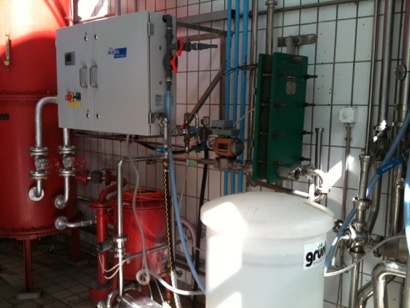
on-site electrochemical formation of disinfectants
Technology
The principle is based on the diaphragm-free electrolysis on a full-diamond electrodes which have been especially designed for such applications.
Free chlorine and other oxidants are synthesized from brine by the electrolytic module.
Background: Active chlorine species such as Cl2, HOCl, OCl, and ClO2 are widely recognized as key oxidants responsible for inactivating cells .
These species can be produced at the anode by the following reactions
2 Cl- ⇒Cl2 + 2 e-
Cl2 + 2OH- ⇒ClO- + H2O + Cl-
Cl2 + 4H2O ⇒2ClO2 + 8 H+ + 8 e-
It has been proven that electrochemically generated oxidants show better disinfecting efficacy than free chlorine only for Escherichia coli and Bacillus subtilis spores at pH 8.2 considering the same content of total oxidants. Recent studies have attributed the higher disinfecting power of electrochlorination to the oxidant role of reactive oxygen species (ROS) such as hydroxyl radical (OH), atomic oxygen (O), hydrogen peroxide and ozone, which can be generated from water by discharge at the anode.
H20 ⇒ .OH + H+ + e-
.OH ⇒ .O + H+ + e-
2OH. ⇒ H2O2
O2 + O. ⇒ O3
(Electrochemical Alternatives for Drinking Water Disinfection Carlos A. Martínez-Huitle and Enric Brillas, Angew. Chem. Int. Ed. 2008, 47, 1998 – 2005)
Field of use
Interesting electrochemical applications of diamond films include the disinfection of water circuits and process water in industrial and power plants, air-conditioning systems, cooling towers (inactivation of algae, Legionella, and germs), warm-water systems in hotels and hospitals (Legionella removal), biologically cleaned wastewater (sewage), and ballast water, and the disinfection of medical instruments.
Example of installed system





